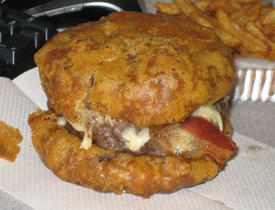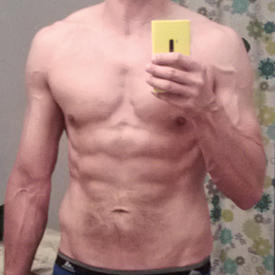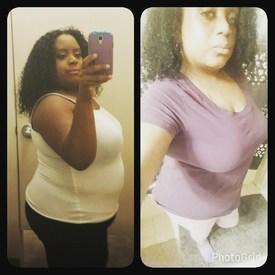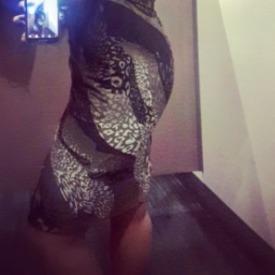MFP calorie burns from strength training way too low?

Fithealthyforlife
Posts: 866 Member
I had been eating a 400-cal surplus for several months and had gained weight on it.
But in the past month, I started a much more intense lifting program (stronglifts). I increased to a 500 cal surplus most days once I started.
But since I started 4 weeks ago, I have not gained any weight. In fact, that 1 lb or so of fat I gained around my middle a few months ago from bulking is actually disappearing. So apparently I'm recomping instead of bulking...on a 500-cal surplus.
The guy who compiled the stronglifts program said to make certain (for a guy) that you eat around 3000 calories a day because it will burn off a lot. Apparently he is right...
MFP says I burn around 200 calories after an hour of stronglifts (using the "weight training" entry in the exercise diary). So I had been eating back those 200 plus the extra 500 on workout days, putting me at around 3250 cal total intake (with properly balanced macros) on workout days. And just the 400-500 calorie surplus alone on non-workout days (putting me at around 3000 on those days).
So is MFP likely to severely underestimate burns from *intense* weight training? Back when my lifting wasn't as intense, the MFP formula (including eating back exercise calories) + additional 400-cal surplus was plenty to make gains off of. It's just not happening anymore though!
I've decided to add another hundred calories on only weight-lifting days, and see what happens. (So, 600-cal surplus on lifting days and 500-cal on non-lifting days).
Please tell me I'm not the only one who went through this...it's so confusing to estimate how much I burn from weight training on this new program.
But in the past month, I started a much more intense lifting program (stronglifts). I increased to a 500 cal surplus most days once I started.
But since I started 4 weeks ago, I have not gained any weight. In fact, that 1 lb or so of fat I gained around my middle a few months ago from bulking is actually disappearing. So apparently I'm recomping instead of bulking...on a 500-cal surplus.
The guy who compiled the stronglifts program said to make certain (for a guy) that you eat around 3000 calories a day because it will burn off a lot. Apparently he is right...
MFP says I burn around 200 calories after an hour of stronglifts (using the "weight training" entry in the exercise diary). So I had been eating back those 200 plus the extra 500 on workout days, putting me at around 3250 cal total intake (with properly balanced macros) on workout days. And just the 400-500 calorie surplus alone on non-workout days (putting me at around 3000 on those days).
So is MFP likely to severely underestimate burns from *intense* weight training? Back when my lifting wasn't as intense, the MFP formula (including eating back exercise calories) + additional 400-cal surplus was plenty to make gains off of. It's just not happening anymore though!
I've decided to add another hundred calories on only weight-lifting days, and see what happens. (So, 600-cal surplus on lifting days and 500-cal on non-lifting days).
Please tell me I'm not the only one who went through this...it's so confusing to estimate how much I burn from weight training on this new program.
0
Replies
-
I've found MFP's weight training entry to be too low as well (as compared to my heart rate monitor). My best advice would be to invest in a heart rate monitor. Generally, the ones with the chest strap are more accurate than those without. I've got a Polar and love it. They will give you a much more accurate calorie burn than the MFP "guesstimates."0
-
I've found MFP's weight training entry to be too low as well (as compared to my heart rate monitor). My best advice would be to invest in a heart rate monitor. Generally, the ones with the chest strap are more accurate than those without. I've got a Polar and love it. They will give you a much more accurate calorie burn than the MFP "guesstimates."
Thanks for the reply and the idea of a heartrate monitor. Not going to be accurate for me though, b/c I tend to get really psyched up before workouts anyway, so it'd probably tell me I'm burning 1000 cal or something. If I got anything, it would be a fit-bit, which uses an accelerometer.
But I don't even feel the need to use a fit-bit right now. Trial and error is fine for the time being. I was just wondering if others have found the strength training estimates here to be too low. So far that's 2 of us!
The workout is the only thing that's changed since I've stopped gaining weight.0 -
General consensus on the boards is that heart rate monitors do a poor job at guesstimating calorie burn on weight training, compared to the steady-state aerobic activity for which they're generally better suited. Weight training doesn't, typically, burn a whole lot of calories.
That said, if you're on a bulk to begin with, increasing your surplus by a bit if you're not seeing the gains you expected may be appropriate.0 -
I find myself so hungry after weight training it can't possibly be only a 150 calorie burn in an hour.0
-
I find myself so hungry after weight training it can't possibly be only a 150 calorie burn in an hour.
Yeah, and it must be more like 300 in my case instead of 200.
I think I'm on the right track...after the extra hundred calories yesterday, I feel like I am more recovered this evening, 24 hours later, than I felt this morning.
Anyone else?0 -
Yes, I am having to find my calorie burn by how I feel. I was maintaining at 1500-1600 calories. I started a formal weight training program about six weeks ago and after 4 weeks of not eating more, I was starving. I decided to increase my calories to 1800. Last night I was starving so now again so am considering 2000 on work out days. After over a year of maintenance, I feel like I am floundering. :sad: I need to find my balance again!0
-
MFP's "strength training" entry is laughable, useful only for old ladies lifting pink dumbbells doing only isolation exercises.
The "circuit training" and/or "high effort calisthenics" are a much better approximation of calories burned while real strength training, which gives a value about 2/3-3/4 of what you'd get if you jogged for the same time period.
I actually don't think it matters much what form you are doing; recovery is more or less constant, set output is dependent on % recovered, whether you are doing heavy doubles, higher rep work, or anything in between.
Uber intense circuit work with heavy glycogen depletion (should feel the burn to the max) a la some Crossfit type stuff burns up the cals even faster than jogging does.0 -
I've found MFP's weight training entry to be too low as well (as compared to my heart rate monitor). My best advice would be to invest in a heart rate monitor. Generally, the ones with the chest strap are more accurate than those without. I've got a Polar and love it. They will give you a much more accurate calorie burn than the MFP "guesstimates."
HRM's are meant for steady state aerobic work.
They tell you nothing about intermittent anaerobic work, whose cal burn isn't even vaguely related to heart rate.
HRM's are useless for strength training calorie estimates.0 -
Really, when you are lifting, you just have to experiment with the numbers. Anytime MFP tries to calculate something it can be way off as it doesn't know if you are curling 8lbs or squatting 400lbs.
I've been "experimenting" since October and am just now figuring out what my actual TDEE is.0 -
MFP's "strength training" entry is laughable, useful only for old ladies lifting pink dumbbells doing only isolation exercises.
The "circuit training" and/or "high effort calisthenics" are a much better approximation of calories burned while real strength training, which gives a value about 2/3-3/4 of what you'd get if you jogged for the same time period.
I actually don't think it matters much what form you are doing; recovery is more or less constant, set output is dependent on % recovered, whether you are doing heavy doubles, higher rep work, or anything in between.
Uber intense circuit work with heavy glycogen depletion (should feel the burn to the max) a la some Crossfit type stuff burns up the cals even faster than jogging does.
Wow! I just looked up the circuit training, and it says I'd burn 500 in an hour! I don't know if I'm actually burning quite that much...but it certainly seems higher than 200.0 -
They're way inaccurate. You're probably better off trying to figure out your TDEE from a calculator like this which allows you to input specific kinds of training:
http://www.doyoueven.com/tdee/
For me (female/126 lbs/5'1/age 24), a 90 minute training session burns somewhere between 400-800 cals depending on what I'm doing that day. This means I maintain on about 2500-2800 cals, so it's no surprise you're not seeing gains on 3250.0 -
They're way inaccurate. You're probably better off trying to figure out your TDEE from a calculator like this which allows you to input specific kinds of training:
http://www.doyoueven.com/tdee/
For me (female/126 lbs/5'1/age 24), a 90 minute training session burns somewhere between 400-800 cals depending on what I'm doing that day. This means I maintain on about 2500-2800 cals, so it's no surprise you're not seeing gains on 3250.
Wow...I'm male, age 28 and 5'9...that's 8 inches taller. So you have to eat over 2800 to gain weight?
I was seeing gains just fine on my old, less intense lifting program, but when I started this one, it just halted. And it's been over a month now.
Your reply was eye-opening. I am going to call it a 400-cal burn per hour and see what happens.
I don't use TDEE. I would, but my activity varies so greatly from day-to-day and week-to-week (yard work, etc.) that it would be a mess. The TDEE calculators all seem to underestimate caloric needs compared to MFP, too.
Thanks for the advice!0 -
I noticed that it is really low if it calculates it at all. I had done the calculations on another site(Health Status dot com) and plugged them in under cardiovascular just to get a rough idea of how many calories to add to my day. I am only weight training to lose weight and tone. I am only able to really do that until my ankle injury clears up.0
-
I think it's way too low especially when you start breaking out a sweat within 10 minutes of doing Stronglifts and MFP says it's only 60 cals burned.
Try upping by 200 every week in addition to what you've already increased and see if you gain from that.0 -
I've found MFP's weight training entry to be too low as well (as compared to my heart rate monitor). My best advice would be to invest in a heart rate monitor. Generally, the ones with the chest strap are more accurate than those without. I've got a Polar and love it. They will give you a much more accurate calorie burn than the MFP "guesstimates."
Heart rate monitors are accurate for steady state cardio only.0 -
There is no good way to measure calories burnt strength training.
Well, the best way is to look at your scale.
If it's going down, you need to eat more . 0
. 0 -
I thought the strength-training option was underestimating the cals burned as well. I googled something like "how many calories burned + weights." I found an algorithm online to help determine cals burned. I ran the #s...and it looks that MFP errs on the side of caution and uses the lowest amount of effort to determine cals burned.
For me, I thought this was fine...better to underestimate than over estimate; BUT, I'm not trying to exactly "gain."0 -
I'm struggling with the same thing! I lift and I want to log the lifts but MFP doesn't seem to be the way. And according to my TDEE and BMR numbers, even minus 20% in an attempt to lose inches while lifting has me at around what MFP considers "maintenance" or higher. Definitely still experimenting- I keep my diary goals set to lower than what I know I should be hitting and just go over, but it's hard to know what my real target is.
Also I'm definitely more hungry the day after lifting and so I listen to my body and eat more those days, especially protein. If anyone has a magic formula, please share!!0 -
If your concerned buy a heat rate monitor and wear it while working out ... end of story0
-
If your concerned buy a heat rate monitor and wear it while working out ... end of story
Except heart rate monitors aren't accurate at all for weight training.....story reopened.0 -
They're way inaccurate. You're probably better off trying to figure out your TDEE from a calculator like this which allows you to input specific kinds of training:
http://www.doyoueven.com/tdee/
For me (female/126 lbs/5'1/age 24), a 90 minute training session burns somewhere between 400-800 cals depending on what I'm doing that day. This means I maintain on about 2500-2800 cals, so it's no surprise you're not seeing gains on 3250.
Wow...I'm male, age 28 and 5'9...that's 8 inches taller. So you have to eat over 2800 to gain weight?
I was seeing gains just fine on my old, less intense lifting program, but when I started this one, it just halted. And it's been over a month now.
Your reply was eye-opening. I am going to call it a 400-cal burn per hour and see what happens.
I don't use TDEE. I would, but my activity varies so greatly from day-to-day and week-to-week (yard work, etc.) that it would be a mess. The TDEE calculators all seem to underestimate caloric needs compared to MFP, too.
Thanks for the advice!
I have to eat near 4K cals to gain @ 6'1" 200ish
Underestimating exercise cals does you no favors when your goal is gaining weight. It is a habit that people get into when "losing weight" that you have to break when gaining is your goal.0 -
MFP's "strength training" entry is laughable, useful only for old ladies lifting pink dumbbells doing only isolation exercises.
The "circuit training" and/or "high effort calisthenics" are a much better approximation of calories burned while real strength training, which gives a value about 2/3-3/4 of what you'd get if you jogged for the same time period.
I actually don't think it matters much what form you are doing; recovery is more or less constant, set output is dependent on % recovered, whether you are doing heavy doubles, higher rep work, or anything in between.
Uber intense circuit work with heavy glycogen depletion (should feel the burn to the max) a la some Crossfit type stuff burns up the cals even faster than jogging does.
Hey...watch it...my dumbbells aren't pink! The rest of it applies though.
:-)0 -
There is no good way to measure calories burnt strength training.
Well, the best way is to look at your scale.
If it's going down, you need to eat more .
.
+1
I don't know why people make it so complicated. Aim to add so much mass a week - if you're not adding it: eat more! If you're adding too much: eat slightly less.0 -
. If anyone has a magic formula, please share!!
TDEE
if your losing weight when you want to be gaining eat more. if your gaining weight and you want to be losing, eat less. No fancy machine is needed just an estimate and a couple of weeks to see if the estimate was accurate. this It really is simpler. I don’t know why people bother with anything else.
edit-for spelling0 -
Eat more. Add 200 calories a day each week until you start gaining what you want.0
-
I think it's way low too (at least according to my HRM). before I understood anything about lifting or working out, I used to go off MFP's calorie thing. I always avoided lifting because it "didn't burn anything".0
-
In for answers... I don't do strong lifts but I do a pretty intense weight training regimen for 30 mins....the calories seem too low to me0
-
I think it's way low too (at least according to my HRM). before I understood anything about lifting or working out, I used to go off MFP's calorie thing. I always avoided lifting because it "didn't burn anything".
Yet still, HRMs are not accurate for weight training.0 -
If you lift and you lift regularly (which you should, if you're doing it properly) then the only answer to go the TDEE route.
And, as others have said, how you pick that TDEE (online calculator, formula of choice, 15xbw in lbs, etc) is only a starting point.
You then run with that number for 2 weeks. Adjust based on real-world results. If you need to eat more: eat more! Then repeat until you feel the need to cut again.0 -
They're way inaccurate. You're probably better off trying to figure out your TDEE from a calculator like this which allows you to input specific kinds of training:
http://www.doyoueven.com/tdee/
For me (female/126 lbs/5'1/age 24), a 90 minute training session burns somewhere between 400-800 cals depending on what I'm doing that day. This means I maintain on about 2500-2800 cals, so it's no surprise you're not seeing gains on 3250.
Wow...I'm male, age 28 and 5'9...that's 8 inches taller. So you have to eat over 2800 to gain weight?
I was seeing gains just fine on my old, less intense lifting program, but when I started this one, it just halted. And it's been over a month now.
Your reply was eye-opening. I am going to call it a 400-cal burn per hour and see what happens.
I don't use TDEE. I would, but my activity varies so greatly from day-to-day and week-to-week (yard work, etc.) that it would be a mess. The TDEE calculators all seem to underestimate caloric needs compared to MFP, too.
Thanks for the advice!
Yeah. I gained 18kg (40lbs) over the past 2 or so years and if I ate less than 3000 I didn't gain.
Seriously I would just pick a number (maybe trying 3500 for now) and eat the same amount every day. Watch the scale and adjust accordingly. It takes out a ton of variables.0
This discussion has been closed.
Categories
- All Categories
- 1.4M Health, Wellness and Goals
- 398.5K Introduce Yourself
- 44.7K Getting Started
- 261K Health and Weight Loss
- 176.4K Food and Nutrition
- 47.7K Recipes
- 233K Fitness and Exercise
- 462 Sleep, Mindfulness and Overall Wellness
- 6.5K Goal: Maintaining Weight
- 8.7K Goal: Gaining Weight and Body Building
- 153.5K Motivation and Support
- 8.4K Challenges
- 1.4K Debate Club
- 96.5K Chit-Chat
- 2.6K Fun and Games
- 4.8K MyFitnessPal Information
- 17 News and Announcements
- 21 MyFitnessPal Academy
- 1.5K Feature Suggestions and Ideas
- 3.2K MyFitnessPal Tech Support Questions


















